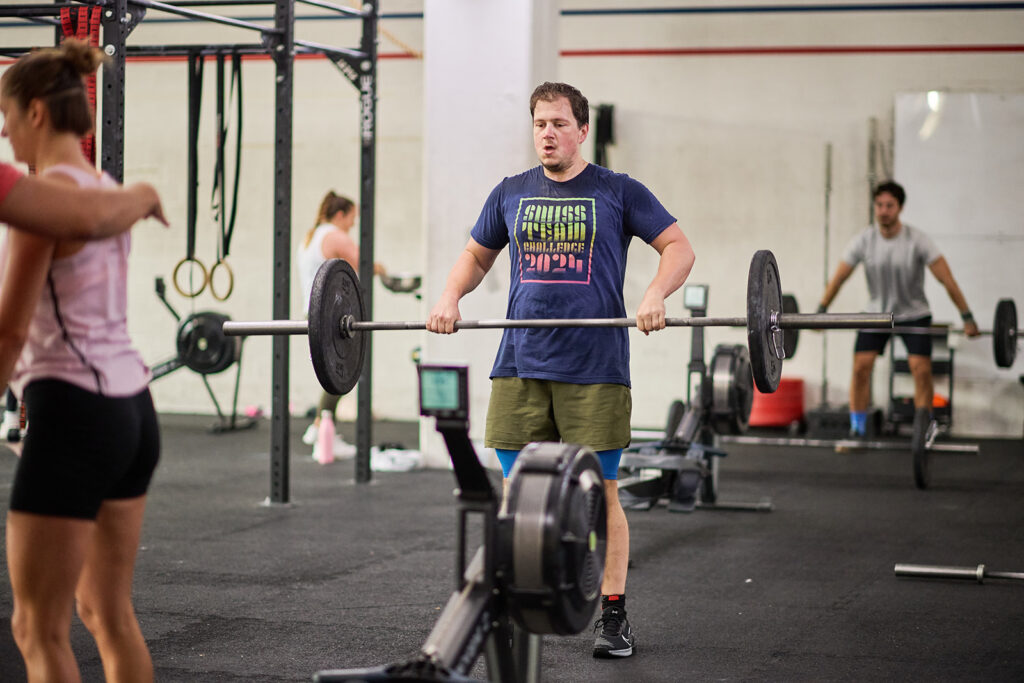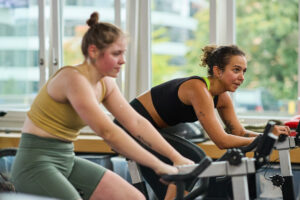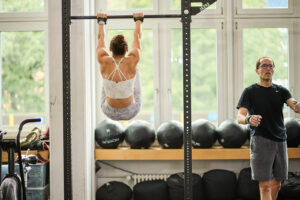
Functional strength training exercises go far beyond the barbell basics—they build the kind of real-world strength that helps you carry groceries, climb stairs, play with your kids, and stay injury-free. While squats, deadlifts, and presses will always have their place, these five underrated movements are the secret sauce to moving better, aging stronger, and living more fully.
These are not “must-do” competition lifts. They’re “should-do” real-life strength builders—perfect complements to a smart training program.
1. Weighted Step-Up
(A functional strength training exercise for single-leg power and balance)
Ever climbed stairs with a toddler on one hip and groceries in the other hand? That’s a weighted step-up in real life. This movement trains unilateral leg strength, balance, and core control. Because you’re working one leg at a time, it also corrects side-to-side imbalances that can go unnoticed in squats or deadlifts.
The elevated step also reinforces proper hip drive and glute engagement, without compressing the spine like some bilateral leg exercises.
Why it matters:
- Improves everyday strength (like stair climbing or hiking)
- Enhances balance and proprioception
- Strengthens glutes, quads, and hamstrings
- Builds hip and knee stability
- Great for injury prevention and rehab
Add dumbbells, a barbell, or kettlebells to make it more challenging. The key is control—don’t rush it.
2. Turkish Get-Up
(The most underrated full-body core movement)
At first glance, the Turkish get-up looks like a complicated dance move. But once you learn it, you realize it’s one of the most functional strength training exercises you can do. With just one kettlebell, you move from lying flat to standing and back down—under control, under load, and with full-body coordination.
It trains core strength and stability, shoulder control, hip mobility, and cross-body coordination. Few movements are this complete.
Why it matters:
- Builds serious core strength
- Strengthens shoulders through full-range control
- Trains your ability to get off the ground—a key marker of aging well
- Improves balance and spatial awareness
- Excellent for injury-proofing your body
Start with no weight or a light kettlebell, and progress slowly. It’s not about speed—it’s about precision.
3. Hang Power Clean
(Explosive strength that carries into sports and life)
The hang power clean trains your ability to generate power—something we lose as we age unless we actively train it. Unlike a full clean, it starts from a higher position (the hang), making it more accessible for beginners.
It develops hip extension, grip strength, upper back control, and timing—all vital for athletic performance and day-to-day agility.
Why it matters:
- Teaches explosive hip power
- Builds coordination between the upper and lower body
- Improves posture and pulling strength
- Supports quick reaction and movement in sports
- Helps prevent slips and falls as you age
As with all Olympic lifts, it’s worth learning from a coach. The technique is part of the training.
4. Crawling Variations
(Low to the ground, high in return)
Bear crawls, crab walks, and lateral crawls might feel like child’s play—but they’re gold for your nervous system and movement patterns. Crawling connects the upper and lower body through the core in a way few exercises do.
These are functional strength training exercises that challenge your stability, mobility, and cross-body coordination all at once.
Why it matters:
- Trains contralateral (opposite-side) movement
- Strengthens shoulders, hips, and core
- Improves posture and spinal alignment
- Great as a warm-up, cool-down, or active recovery
- Builds resilience in small stabilizing muscles
Try 20–30 second crawl intervals. You’ll be surprised how much it burns—and how quickly it improves your movement quality.
5. Reverse Sled Drag
(Knee-friendly leg strength with huge benefits)
The sled is one of the most joint-friendly tools in any gym. And dragging it backwards takes the benefits to the next level. The reverse sled drag targets your quads, strengthens your knees, and pumps blood into connective tissues without compressing your spine or loading your joints awkwardly.
It’s brutally simple—and simply brutal.
Why it matters:
- Builds bulletproof knees and healthy quads
- Improves blood flow and tissue health
- Develops work capacity without impact
- Fantastic for injury rehab or prevention
- No complex technique required
Want stronger legs and knees that don’t ache when you take the stairs? Drag the sled.
Final thoughts
If squats and deadlifts are the main course, these movements are the missing ingredients that turn your training into a complete, balanced recipe for performance and longevity.
Adding these functional strength training exercises into your weekly plan doesn’t require an overhaul—just intention. Pick one or two, ask a coach for help if needed, and integrate them into your warm-ups, cooldowns, or accessory work.
You’ll move better, feel better, and build a body that’s strong for life—not just for the gym.




